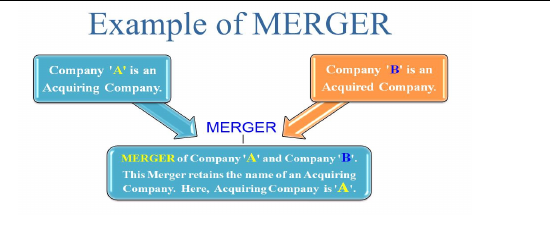Question based on AU SM Solved Assignment and other course
Answer:
Before we understand Merger, First, let’s find out the simple meaning of an acquiring company and acquired companies.
- Acquiring Company is a single existing company that purchases the majority of equity shares of one or more companies.
- Acquired Companies are those companies that surrender the majority of their equity shares to an acquiring company.
Definition: Merger is a combination of two companies where one corporation is completely absorbed by another corporation.
A merger happens when two firms, often of about the same size, agree to go forward as a single new company rather than remain separately owned and operated
The less important company loses its identity and becomes part of the more important corporation, which retains its identity. A merger extinguishes the merged corporation, and the surviving corporation assumes all the rights, privileges, and liabilities of the merged corporation.
Merger is a technique of business growth. It is not treated as a business combination. Merger is done on a permanent basis. Generally, it is done between two companies. However, it can also be done among more than two companies.
During Merger, an acquiring company and acquired companies come together to decide and execute a merger agreement between them.
After Merger, acquiring company survives whereas acquired companies do not survive anymore, and they cease (stop) to exist.
- Merger does not result in the formation of a new company. The management of acquiring company continues to lead (direct) the merger.
- Merger is not the same as a consolidation, in which two corporations lose their separate identities and unite to form a completely new corporation.

In the above example, Company ‘A’ and Company ‘B’ are operating (existing) in the market. Company ‘A’ is an acquiring company, and Company ‘B’ is getting acquired by Company ‘A’. In other words, Company ‘B’ gets merged with Company ‘A’.
In this example of merger, Company ‘A’ will purchase the majority of equity shares (ownership shares) of Company ‘B’. Company ‘A’ will take over the assets and liabilities of the Company ‘B’. The shareholders of the Company ‘B’ will be given the shares of Company ‘A’. The acquiring Company ‘A’ will continue to operate (function) by its erstwhile (former) name.
1. Effects of Merger
- Unilateral Effect : The merged entity may also have a unilateral incentive to increase the price of one or more of the products sold by the merging firms if a significant proportion of consumers view the two merging firms as their first and second choices. In the pre-merger equilibrium, firms have chosen their prices to maximize profits, taking into account their perceptions about consumers‘ willingness to switch to other products.
Thus, a firm would not have an incentive to increase its price independently prior to the merger because it has already determined that the benefit of a higher price would be outweighed by the cost of lost sales to competitors. However, if a large enough proportion of the lost sales by one merging firm would be captured by the other merging firm, then a price increase could be profitable after the merger.
- Coordinated Effects : It occur when a merger increases the likelihood that competitors will coordinate – either tacitly or expressly – to raise prices. A merger may enhance the ability to coordinate by reducing the number of independent competitors. This is more likely to occur if the existing number of competitors is already relatively small. Many other factors also affect the ability to coordinate. For example, all other things equal, it is easier for competitors to reach and monitor agreements if the products are relatively homogeneous and the pricing by individual competitors is relatively transparent.
2. Demergers
A demerger is the opposite of a merger, involving the splitting up of one entity into two or more entities. An entity which has more than one business, may decide to ‘hive off’ or ‘spin off’ one of its businesses into a new entity. The shareholders of the original entity would generally receive shares of the new entity.
If one of the businesses of a company is financially sick and the other business is financially sound, the sick business may be demerged from the company. This facilitates the restructuring or sale of the sick business, without affecting the assets of the healthy business. Conversely, a demerger may also be undertaken for situating a lucrative business in a separate entity. A demerger, may be completed through a court process under the Merger
Total Views: 26
